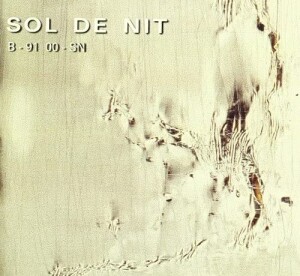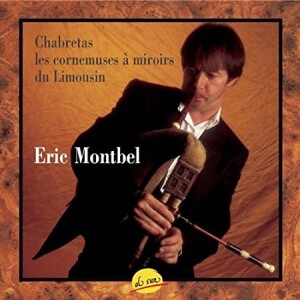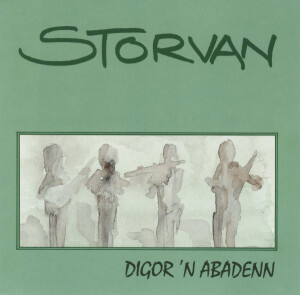Various artists’ Dudas Latvija (Latvian Bagpipes)
Sol de Nit’s B-91 00-SN
Eric Montbel’s Chabretas les cornemuse a miriors du Limousin
Storvan’s Digor ‘N Abadenn and An deiziou kaer
 Not surprisingly, my CD collection holds much more than just Irish, Scottish, and English music! In preparation for the next Wild Hunt festival, I’ve been looking at piles of CDs from bagpipe-based groups from ’round the world. ‘Tis amazing how much good piping music there is even when one avoids the standard Irish and Scottish schools of music!
Not surprisingly, my CD collection holds much more than just Irish, Scottish, and English music! In preparation for the next Wild Hunt festival, I’ve been looking at piles of CDs from bagpipe-based groups from ’round the world. ‘Tis amazing how much good piping music there is even when one avoids the standard Irish and Scottish schools of music!
The liner notes to Dudas Latvija include a superb engraving from circa mid-1500s that shows a Latvian bagpipe, showing just how far back the folks from Latvia enjoyed the instrument’s drone and the bacchanalia that frequently accompanied its playing. (The cover art is a picture of a young, apparently naked bagpiping lad in the arch of castle ruins.) In time, as happened in England and other countries, playing the instrument was officially discouraged, even prohibited, and by the 20th century the practice had all but died out. And as in England, a dudas revival began in the 1970s, and now performers and instrument makers are active in Latvia. Dudas Latvija showcases seven remarkable pipers (Austris Grasis, Maris Jansons, Maris Jekabsons, Andris Kapusts, Valdis Muktupavels, Maris Muktupavels, and Raigo Stalts) who not surprisingly sound alike.
 What you will hear on this album are traditional numbers as well as some new compositions created especially for this collection. These are not the mellow pipes of the Northumbrian tradition, but rather are quite loud and sound like a pig being squeezed real hard! There are vocals here — think Russian such as groups like Ensemble Pesnokhorki and Mylliart and you’ll get the idea! This is loud, boisterous music intended to keep the village dancers and singers quite happy, thank you! Cut three, ‘Vaidi’, has some of the nicest piping harmonies I’ve ever heard, and cut two, ‘Alus dziesma (the Beer Song)’, has vocals that any choir of not-so-nice church-goers would envy!
What you will hear on this album are traditional numbers as well as some new compositions created especially for this collection. These are not the mellow pipes of the Northumbrian tradition, but rather are quite loud and sound like a pig being squeezed real hard! There are vocals here — think Russian such as groups like Ensemble Pesnokhorki and Mylliart and you’ll get the idea! This is loud, boisterous music intended to keep the village dancers and singers quite happy, thank you! Cut three, ‘Vaidi’, has some of the nicest piping harmonies I’ve ever heard, and cut two, ‘Alus dziesma (the Beer Song)’, has vocals that any choir of not-so-nice church-goers would envy!
Sol de Nit is a Catalan ensemble that consists of Laura Imbert-Bouchard on violin; Cati Plana on diatonic accordion; Txus Bañón on mandolin, guitar, gralla, and voice; Francina Turon on cello and voice; Jordi Vallverdú on bloody near everything including percussion, catalan and Bulgarian bagpipes, whistles, and gralla; and Montse Bellmunt who’s simply listed as ‘dancing entertainment’. The Sol de Nit (Night Sun) repertoire is based around the music from their native Catalonia but obviously given the Bulgarian bagpipes includes influences from elsewhere in the world. This is not an album of bagpipe, but rather an album in which bagpipes are an element. (If you want pure piping, check out  Brendan Foreman’s review of Moebius, the English bagpiping trio, which features nothing but piping.) This is Sol de Nit’s debut recording, but it shows a deft touch by not attempting to overwhelm the listener with a Blowzabellian ‘wall of sound’ approach. Bagpipes, accordion, and violin are the core essence of this group as is true in much of the Breizh tradition which creates a similar feel using just pipes and accordion — see the review I did of Duo Bertrand’s Musiques d’hier pour Aujourd’hui — with the other instruments filling out the sound. Neat stuff, well worth tracking down!
Brendan Foreman’s review of Moebius, the English bagpiping trio, which features nothing but piping.) This is Sol de Nit’s debut recording, but it shows a deft touch by not attempting to overwhelm the listener with a Blowzabellian ‘wall of sound’ approach. Bagpipes, accordion, and violin are the core essence of this group as is true in much of the Breizh tradition which creates a similar feel using just pipes and accordion — see the review I did of Duo Bertrand’s Musiques d’hier pour Aujourd’hui — with the other instruments filling out the sound. Neat stuff, well worth tracking down!
I’ll finish out this review with three CDs from Breizh, known in English as Breton or Brittany. Eric Montbel’s Chabretas les cornemuse a miriors du Limousin is music from the Limousin region of France. (Chebretas is the name for bagpipes from that region.) The bagpipes played in the Limousin are very diverse; some are even the result of importation from the north and the south of France. The chabreta is equipped with a chanter and two drones; the large drone rests on the musician’s arm. (Never entirely trust translation  software — Google translated this as ‘The chabreta is a bagpipe equipped with an oboe and two bumblebees: the large bumblebee rests on the arm of the musician.’ I can easily guess how the software got there, but it’s still amusing!) This sweet, gentle music suitable for listening to on a warm Midsummer’s evening as Eric has a very light touch to his playing. Montbel’s exquisite playing is rounded out by the addition of his musician friends Jean François Vrod (violin), Guy Bertrand (flutes) and Richard Montségu (percussion), all of whom do a more than superb job.
software — Google translated this as ‘The chabreta is a bagpipe equipped with an oboe and two bumblebees: the large bumblebee rests on the arm of the musician.’ I can easily guess how the software got there, but it’s still amusing!) This sweet, gentle music suitable for listening to on a warm Midsummer’s evening as Eric has a very light touch to his playing. Montbel’s exquisite playing is rounded out by the addition of his musician friends Jean François Vrod (violin), Guy Bertrand (flutes) and Richard Montségu (percussion), all of whom do a more than superb job.
And now two CDs from Storvan, a Breizh group. This is a big group consisting of Christian Lemaitre on violin and guitar, Frank Le Bloas on bouzouki and bass, Herve Guillo on flutes, Christian Faucheur on bombarde and whistle, Sylvere Morrison on piano and synthesizer, Franck Yhuel on percussion, and Francois Daniel on bass. This group shows the Welsh roots of the Breizh culture ever so well. Bombardes, or bagpipes if you prefer, are the dominant sound of this music that obviously is quite well suited for a fest noz (a Breton traditional festival).
 Storvan is an imaginary name drawn from Julien Gracq’s novel To the Castle of Argol, which is considered a masterpiece of surrealism. Now that has nought to do with Storvan’s music. Storvan is grounded in the playing of Christian Lemaître who took part in the majority of the great Breizh groups from the ’70s onward. What you get on both Digor ‘N Abadenn and An deiziou kaer is music played well with both enthusiasm and considerable skill. If you like good traditional Irish music, it’s me guess that this’ll be to your liking. There’s nothing musically surprising here, which is true of most Breizh music, but it is pleasant. Like Eric Montbel’s Chabretas, these CDs are indeed sweet, gentle music suitable for listening to on a warm Midsummer’s evening.
Storvan is an imaginary name drawn from Julien Gracq’s novel To the Castle of Argol, which is considered a masterpiece of surrealism. Now that has nought to do with Storvan’s music. Storvan is grounded in the playing of Christian Lemaître who took part in the majority of the great Breizh groups from the ’70s onward. What you get on both Digor ‘N Abadenn and An deiziou kaer is music played well with both enthusiasm and considerable skill. If you like good traditional Irish music, it’s me guess that this’ll be to your liking. There’s nothing musically surprising here, which is true of most Breizh music, but it is pleasant. Like Eric Montbel’s Chabretas, these CDs are indeed sweet, gentle music suitable for listening to on a warm Midsummer’s evening.
That’s all for now. Me wife, Brigid, got word of a new cafe in the Marketplace specializing in Northern French cooking, so we’re off to dine there. I wonder if they’ll have bière de garde?
(UPE, 2000)
(Puntetro, 2000)
(Al Sur, 1995)
(Kelti Musique, 1991)
(Kelti Musique, 1996)
